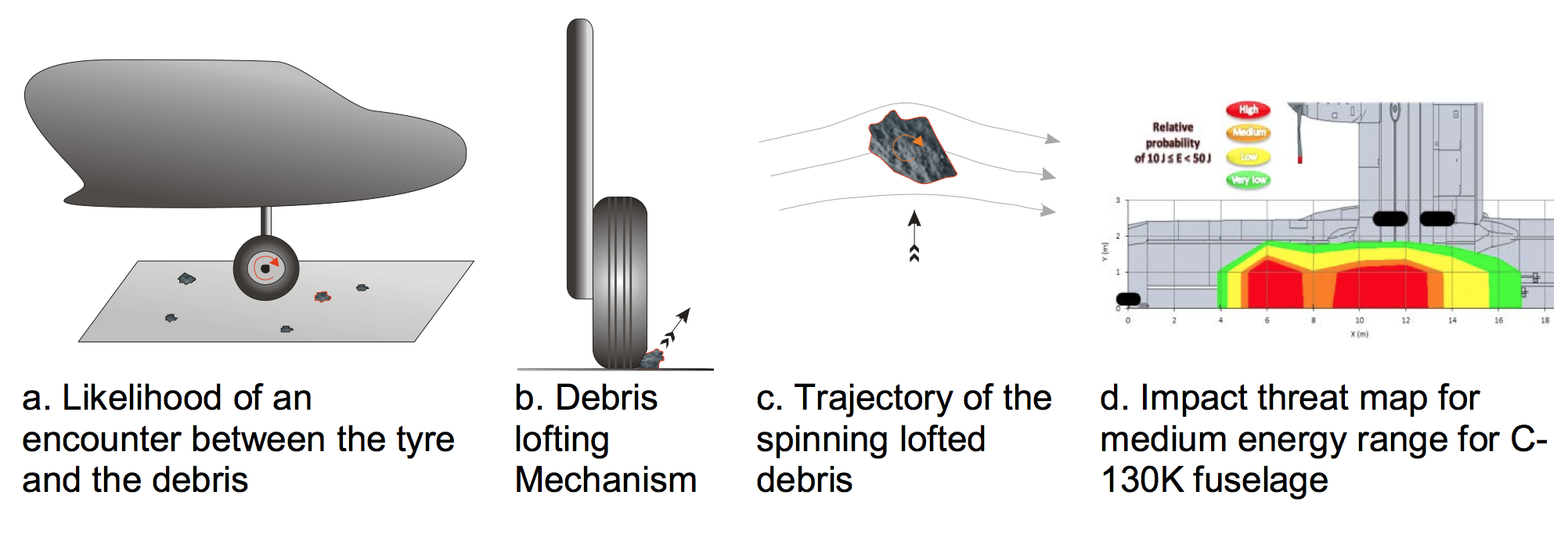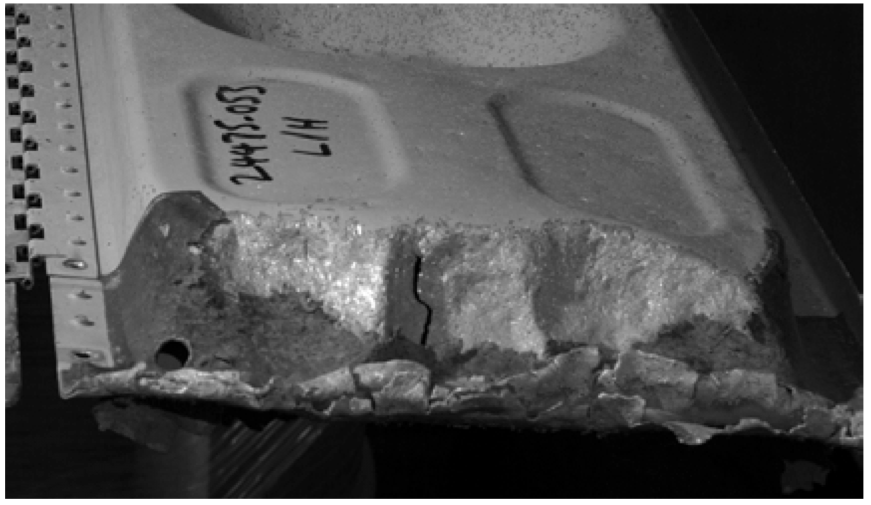16. Introduction of stone deflector in the design of the Airbus A400M Aircraft
Submitting Institution
Imperial College LondonUnit of Assessment
Aeronautical, Mechanical, Chemical and Manufacturing EngineeringSummary Impact Type
TechnologicalResearch Subject Area(s)
Engineering: Aerospace Engineering, Interdisciplinary Engineering
Summary of the impact
Runway stones thrown up by aircraft undercarriage wheels can cause
considerable damage to the
aircraft structure. A model of runway debris lofting developed at Imperial
College has been used for
the new A400M military transport aircraft, which Airbus reported was
`absolutely needed' during the
successful development of a nose wheel debris deflector [5. A]. This
deflector dramatically reduces
the incidence and severity of the runway debris impacts and the associated
maintenance costs and
downtime of the new aircraft. Airbus has received 174 orders to date for
the A400M. An indication
of the cost savings comes from the Hercules C130K, the predecessor of the
A400M, which
incurred costs of up to £1M for each aircraft on active service in
Afghanistan for the repair of
runway debris damage. This cost is now eliminated for the Airbus A400M
aircraft.
Underpinning research
The underpinning research responsible for this impact was led by Dr
Greenhalgh from October
2006 to 2010 at the Aeronautics Department of Imperial College London. It
was funded through a
DSTL EPSRC CASE studentship. Before work started, there had been no
realistic, reliable means
of predicting the impact threat from runway stones hitting the
undercarriage of the aircraft. Using
information on runway debris characteristics, aircraft and tyre geometry
for take-off and landing
profiles, a model was devised to predict the likelihood of a tyre/debris
encounter. This model was
published as part of Reference 1. The next stage in the research was to
model the mechanisms by
which the debris, tyre and runway surface interacted to cause lofting and
to determine the initial
direction and speed of the projected debris. Initially, finite element
(FE) models using contact
mechanics were developed which captured the physics of the interactions
between the hard stone,
the ground and the compliant rubber tyre. The first models assumed solid,
cylindrical tyres [2, 3],
and these were extended to more realistic configurations, which, using
data from indentation
testing on aircraft tyres [4], included the inflation pressure and
detailed tyre geometries [1]. All
these models were validated against bespoke drop-weight experiments,
monitored with high speed
video, which reproduced key aspects of the contact conditions between the
stones, tyres and
ground. The understanding gained during the FE and experimental
investigations, enabled the
development of a physically-based analytical model [5] which was the first
to provide an insight into
the critical parameters which dictated the severity of the stone lofting
processes, such as tyre
geometry, stone mass and shape, and aircraft speed, and predicted the
direction and initial speed,
which included a significant spin component [1]. The kinetic energy
associated with spin could be
as much as 50% of the translational component. During a second research
project funded directly
by Airbus the models were further refined to incorporate the effect of the
multiple interactions that
occur when a wheel encounters a group of runway stones and to include the
geometry of the tyres
used on the Airbus A400M. Sang Nguyen received his PhD from the department
of Aeronautics
Imperial College for this work.
Having established a reliable model for the initial state of the lofted
stone at the start of its
projected motion, the next stage of research investigated the subsequent
motion of the debris to
enable prediction of the severity of any resulting impact on the aircraft.
This work was funded
directly by Airbus during 2011 and was led by Dr. Emile Greenhalgh with
Dr. Nguyen as a
postdoctoral researcher. Aerodynamic models were developed for the
interaction between the
spinning lofted stone and the airflow in the wake of the undercarriage
wheels and beneath the
fuselage [6]. The research focussed on the relative interaction between
the different aerodynamic
flows (such as tyre wake, aircraft boundary layer, ground effects and
turbulence) and the rapidly
spinning stones and culminated in the production of 'threat maps' which
identify the sites on the
aircraft lower fuselage that are exposed to the most severe impact
conditions.
 Figure 1: Overview of key research that led to impact
Figure 1: Overview of key research that led to impact
This is a unique capability that allows designers to optimise the damage
tolerance of
aerostructures exposed to such impact threats (i.e. undercarriage
components and lower
fuselage). The location and severity of debris damage predicted by the
model has been shown to
be in good agreement with that observed on aircraft such as C130K
Hercules.
References to the research
* References that best indicate quality of underpinning research.
[1] S.N. Nguyen, E.S. Greenhalgh, R. Olsson, L. Iannucci, P.T. Curtis,
"Improved Models for
Runway Debris Lofting Simulations", The Aeronautical Journal, Vol 113,
Issue 1148, pp. 669-681,
(2009)
This paper was the first model to quantify stone encounters for
realistic runway debris distributions
which was an essential step towards accurate assessment of the threat
posed by runway debris.
*[2] S.N. Nguyen, E.S. Greenhalgh, R. Olsson, L. Iannucci, P.T. Curtis,
"Modelling the Lofting of
Runway Debris by Aircraft Tyres", AIAA International Journal of Aircraft,
Vol 45, Issue 5, pp. 1701-1714,
(2008) DOI: 10.2514/1.35564
This was the first instance of a computational model to simulate the
stone lofting mechanism and,
together with the experimental validation, produced vital information on
the mechanism by which
spin is imparted to the debris.
*[3] S.N. Nguyen, E.S. Greenhalgh, R. Olsson, L. Iannucci, P.T. Curtis,
"Parametric Analysis of
Runway Stone Lofting Mechanisms", International Journal of Impact
Engineering, Vol 37, Issue 5,
pp. 502-514, (2010) DOI: 10.1016/j.ijimpeng.2009.11.006
*[4] S.N. Nguyen, E.S. Greenhalgh, R. Olsson, L. Iannucci, P.T. Curtis,
S. Longstaff, "Experimental
Characterisation of Tire Indentation by Simulated Runway Debris", Strain:
An International Journal
for Experimental Mechanics, Vol 47, Issue 4, pp. 343-350, (2011) DOI:
10.1111/j.1475-1305.2009.00704.x
[5] S.N. Nguyen, E.S. Greenhalgh, R. Olsson, "Analytical Modelling of
Runway Stone Lofting",
AIAA International Journal of Aircraft, Vol 48, Issue 4, pp. 1412-1421,
(2011) DOI:
10.2514/1.C031306
This paper described a physically-based analytical model which was the
first to provide an insight
into the critical parameters which dictated the severity of the stone
lofting processes, such as tyre
geometry, stone mass and shape, and aircraft speed.
[6] S.N. Nguyen, E.S. Greenhalgh, J.M.R. Graham, A. Francis, R. Olsson,
"Methodology for
Predicting the Threat of Runway Debris Impact to Large Transport Aircraft"
53rd
AIAA/ASME/ASCE/AHS/ASC Structures, Structural Dynamics and Materials
Conference,
Honolulu, 23-26, (April 2012) Paper no: AIAA 2012-1377.
Details of the impact
Military aircraft encounter a significant problem caused by damage from
debris or stones lofted by
the aircraft wheels onto the aircraft structure (see Figure 1 below). The
conventional approach to
designing against this threat is to essentially make an assumption about
the worst impact energy
(typically 50J) likely to occur during the lifetime of the aircraft. The
structure would then be
designed to tolerate any damage produced from such an impact when exposed
to the most severe
mechanical loading anticipated during its lifetime (i.e. design ultimate
load). However, such an
approach is not rigorous, and makes several assumptions regarding the type
of impact conditions
and the resulting damage. With weight being critical for aerospace design,
overdesign of a
structure imparts a considerable penalty; but if the
perceived level of threat is underestimated, this could
lead to parts of the aircraft being susceptible to
damage during service, with potentially catastrophic or
very costly implications. The latter is the case for the
Lockheed C130K Hercules transport aircraft which the
RAF have been using in the Gulf and Afghanistan and
for which repair of runway debris damage is up to £1M
per aircraft (source: verbal discussions with MoD and
DSTL staff [A]).
 Fig 1 Runway debris damage to the leading edge of an undercarridge door of a transport aircraft
Fig 1 Runway debris damage to the leading edge of an undercarridge door of a transport aircraft
During initial work investigating the physics of the
interactions between the hard stone, the ground and the compliant rubber
tyre, the Head of
Landing Gear Structures in Airbus Military (Spain) approached Dr
Greenhalgh. He was interested
in further developing the understanding of lofted debris and provided
support for this work as
outlined in section 2.
This research then had an immediate pathway for significant impact and
has been relied upon by
Airbus during the 2011 in designing the Airbus A400M Aircraft. The
research allowed Airbus to
quantify the severity of the threat to aircraft from runway debris and so
enabled engineers to
reliably design efficient aircraft structures to tolerate this threat [A].
The debris lofting model was
able to predict the potential damage to the lower fuselage of the A400M
aircraft from lofted runway
debris. This was used in the design of a deflector plate for the nose
landing gear (NLG) which
would protect the lower fuselage from lofted stone damage. In particular,
the models developed at
Imperial were used to optimise the shape and exact position of the
deflector plate [A].
In May 2012, The Head of Landing Gear Structures at Airbus commented that
the research
undertaken by Imperial College was "absolutely needed, because landing on
unprepared runways
was a new concept inside the Airbus Aircraft Family" and went on to state
"The model identified the
most critical parts on the fuselage, predicting in a reliable way the
probable trajectories for a stone
lofted by the NLG tyres and making it possible to start developing
protections and devices that help
to minimize the effect of such impacts during the operation on unprepared
fields" The results of the
Imperial model "confirmed the need of a stone deflector to help protect
the belly of the A400M" and
allowed Airbus "to improve the efficiency of such a stone deflector in the
series design". The results
of the model developed have subsequently been shared inside the Airbus
Community, and have
raised interest from other areas as such as Power Plant and Dynamic
Analysis [B].
As has been demonstrated above, the research has had a direct impact on
the design of the new
Airbus A400M. This has enabled one of the features of the plane to be
reduced operational costs
compared to its predecessor the Hercules C130K. The A400M has had
successful test flights and
is now being manufactured with over 174 orders in place as at 30th June
2013 [C]. The results of
tests undertaken in the summer of 2013 on an unsurfaced runway covered
with gravel of different
sizes confirmed predictions made by the model and the efficacy of the
deflector plate [B].
Sources to corroborate the impact
A. Flight lieutenant, Hercules IPT - Confirmation of the runway debris
repair costs of £1M for
a Hercules C130K
B. Head of Landing Gear Structures, Airbus Military - Corroboration of
the impact of the
research on Airbus design and results of subsequent full scale test
landing on the prototype
aircraft.
C. Airbus Military "Orders, Deliveries, In Operation aircraft by country-
Worldwide" pg. 3
(2013)
http://www.airbusmilitary.com/Portals/0/Images/Aircraft/OrdersAndDeliveries/AMOrdersDeliveries.pdf
Archived here
on 17/09/2013.Corroboration of 174 orders for the Heavy Transport
Aircraft Airbus A400M.